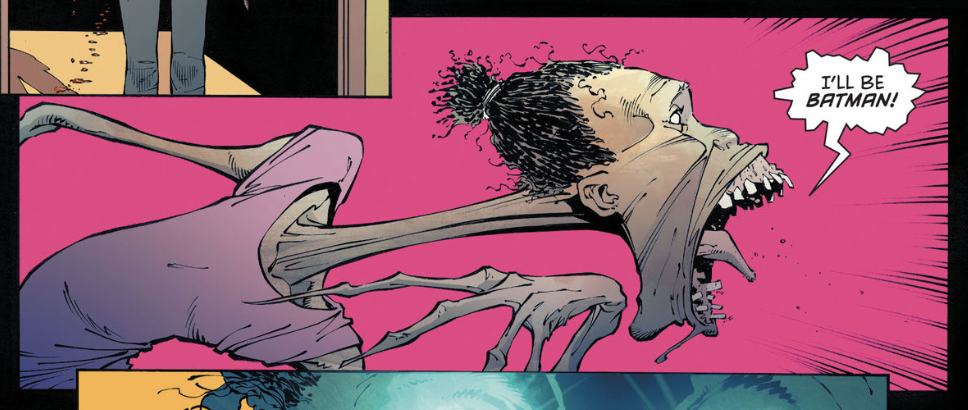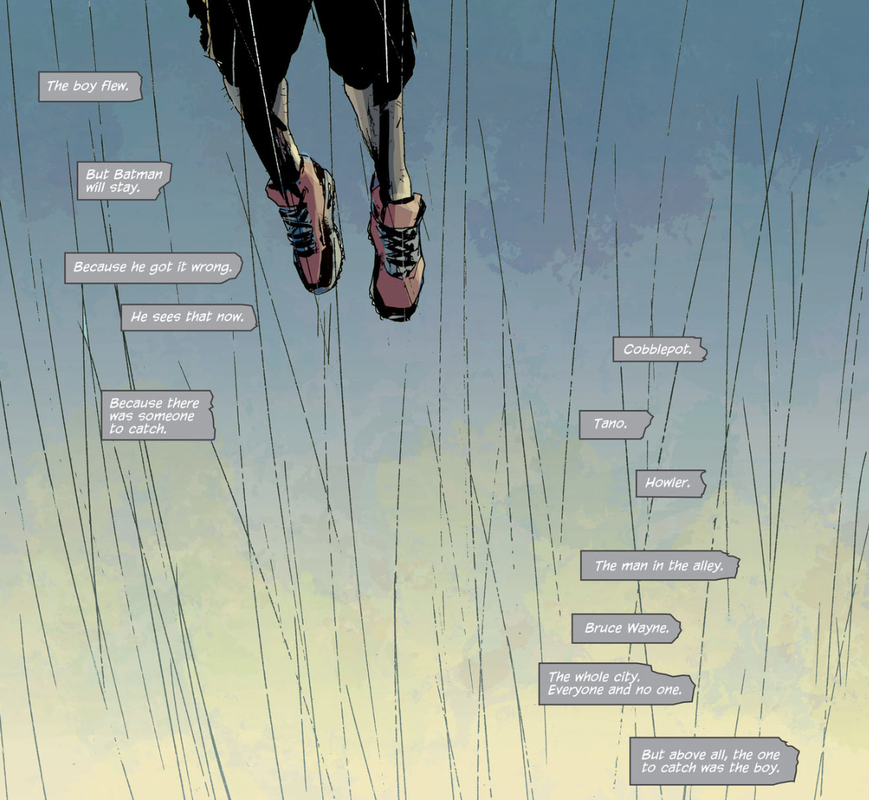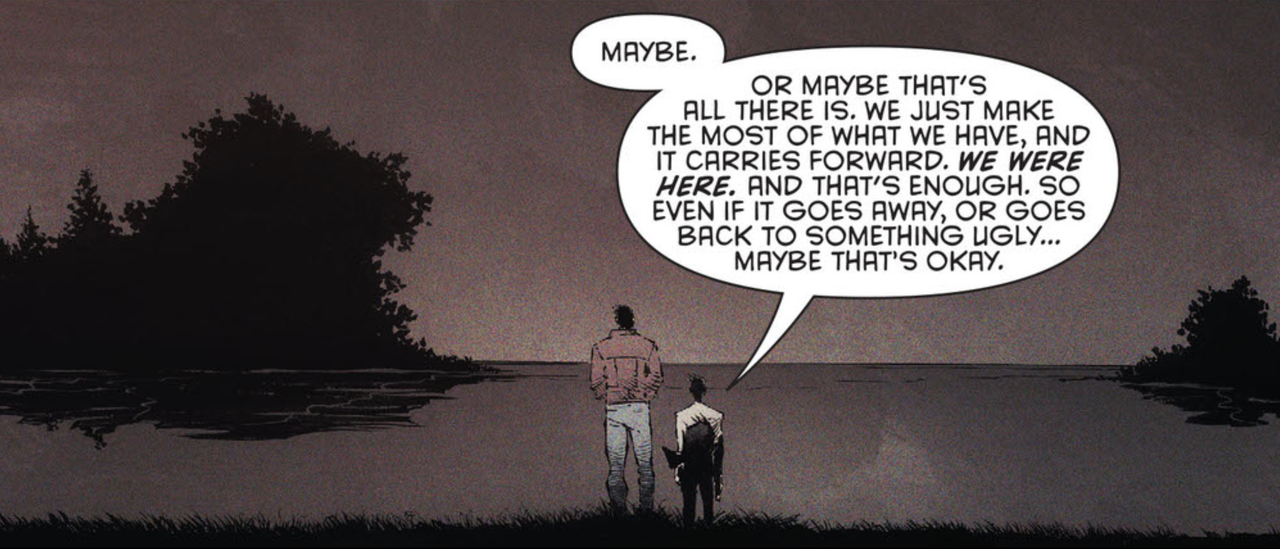A Love Letter to Snyder and Capullo’s Batman: Superheavy
Scott Snyder and Greg Capullo’s Batman has gotten constant praise since its start, and with how often it’s recommended to new comic readers, I found it easy to call it overrated. This isn’t helped by my admittedly unwarranted resentment towards its first arc, Court of Owls. Yes, it is very good, but it seems like everyone unanimously decided to stop there, which is a complete shame, as I think the book just gets better. It then makes sense that this run’s last arc, Superheavy (or if you’re reading in trades, Superheavy and Bloom), is my favorite. Moreover, issue #44, which is attached to the Superheavy arc, is my favorite Batman comic of all time. To make up for the uneven distribution of love given towards this run’s arcs, in this post, I’m going to gush over Superheavy (with minor spoilers) in hopes that if you haven’t, I can convince you to read past Court of Owls.
Part 1: Bloom
I want to start by discussing the book’s main antagonist, Mr. Bloom. As a character, he isn’t all that interesting, but I think he serves the story so perfectly to the point that I don’t really care. It may even be for the best. He represents anger and dissatisfaction in Gotham, preying on the disadvantaged by giving them these microchips that will enhance their power. Under the guise of revolution, he creates chaos in Gotham, pitting individuals and groups against one another. These microchips mutate the user’s body and more often than not kill them. There is a horrifically memorable scene midway through the arc in which a little girl cuts herself to insert the chip, wanting to protect Gotham in the absence of Bruce’s Batman. As she walks out to announce that she will be Batman, her body begins to bend, grow, and crack dreadfully until she explodes. For as repulsing as this scene is, it’s equally depressing and left me empty. With the time gap between this arc and the previous one, Endgame, Gotham has been feeling unnatural.

We do get an issue advertised as the origin of Mr. Bloom, but I would say it doesn’t explain much. Despite its false advertising, issue #44 is phenomenal. I think Snyder at this point has gotten more nuanced with his writing, and I know this is a big claim, but this truly may be one of the most socially conscious Batman issues. I read a few months ago that James Tynion IV commented on how writing Batman is different now that being a billionaire isn’t cool anymore. Most answer this in one of two ways. Either Bruce temporarily loses his wealth or he donates a lot. To commentate on the latter, I think that is lazy writing that further pushes the notion that the more money one donates equates to them being better a person, without considering the limits to which people can donate nor the selfish reasons people do so. Why should we put Bruce on a pedestal for donating when he has way beyond the wealth to do so? And he’s assumably getting tax breaks and building social credit when he donates. This isn’t to say people should treat him nasty, but I feel as though in an attempt to build his character, many writers (unintentionally) relate money to morals in a way that favors the rich. So when Snyder addresses how Bruce’s donations don’t absolve him of further responsibility I was somewhat shocked. It wasn’t that I didn’t expect this from Snyder, but that I didn’t expect this from a Batman comic. In issue #44 Snyder talks about how putting money into rebuilding and uplifting lower-class neighborhoods leads to gentrification and the displacement of families. The solution isn’t then to not put money into these communities, but to do so while having measures in place that would allow residents to stay such as rent control. Bruce is well-intentioned, and no one is saying he is evil because he has money, but by showing the complexities that surround simply throwing money at issues, a more nuanced understanding of those issues is uncovered.
This issue tackles systemic issues that lead to the death of a teenage boy, issues that aren’t solely caused nor can solely be solved by costumed individuals. In this issue, the boy had inserted the microchip and grew wings, but unable to control them, he fell to his death. Mr. Bloom is to blame for giving him the chip, but so is the cop who racially profiled the boy and shot him, and so is the man who robbed and burned down the boy’s father’s bodega, and so is Bruce Wayne, whose money drove out families and caused crime to rise as a desperate response.
“The whole city. Everyone and no one. But above all, the one to catch was the boy. Before he fell.”

I want to note how beautiful the art is both in this issue and the entirety of the run. Frequent Snyder collaborator Jock works on a few issues of this run, with issue #44 being one of them. Greg Capullo does the art for the majority of the book and it really is great. So great that it has come to define the character since. I’m no artist, although I’m attempting to learn, so I can’t really comment on the art further than saying I liked it but did want to acknowledge those two as I’ve been name-dropping Snyder a lot.
Part 2: Now
Jim Gordon is Batman and he operates a robotic mech batsuit called Rookie. If you’re familiar with Snyder’s first “run” with DC (by this I mean Black Mirror to Death Metal) you’ve probably noticed an increase in extremism. Now I don’t mean this in a political or religious context, but quite literally the stories and characters become more extreme. In turn, the one thing that is lost is the quiet investigation that the run started with and many fans want from Batman. The detective atmosphere is somewhat abandoned, but the emotion and sincerity found in those quiet moments aren’t gone. Instead, it’s greater here than anywhere else in the run. As you’d expect with this being the final arc, everything the previous ~40 issues have been building up concludes here, and Snyder really nails the writing.
As a second warning, I will be spoiling some parts of the book, though I don’t think spoilers will impact your enjoyment of the title very much. Now that you’ve been warned, Joker and Bruce are alive and neither are in costumes. At the end of the previous arc, Endgame, the two seemingly die in a cave right next to some sort of regenerative pit. Life goes on without them as there is a decent time jump from that arc to this one, but when we see Bruce next he’s living a normal life. He’s not Batman, nor does he remember ever being Batman. Alfred is aware he is alive, but wanting him to live without tragedy, he decides to not interfere with his life. I love this so so much as towards the end of Zero Year, we see Alfred begrudgingly at the request of Bruce tell Julie (the what-could’ve-been love interest for Bruce if he was to live a life not as Batman) Bruce isn’t available, cementing Batman and more or less killing Bruce. So for him to see Bruce happy with this same girl after years of sacrifice, he of course doesn’t want to bring Batman back. Throughout the story, Bruce occasionally goes to a bench overlooking a lake, and always there is Joker, though, presumably like Bruce, doesn’t remember being Joker. There, we get what is honestly my favorite quote from a comic by Joker,
“We were here. And that’s enough. So even if it goes away, or goes back to something ugly… maybe that’s okay.”
Everyone reading knows it will go back to something ugly as that’s the nature of these characters. Bruce has to return as Batman and Joker has to be evil, but for a brief period, their stories can conclude. We can enjoy the now, knowing it won’t last.

Since Death of the Family and being a focal point of Endgame, the idea that Joker is immortal has been thrown around a lot. In Endgame, Gordon discovers papers and photographs that indicate Joker has been around for centuries, yet we also see his origin in Zero Year, so were those documents doctored? I guess so, but it really is left unclear. Superheavy then throws in the idea that Batman is immortal. It’s revealed Batman has a machine that in case something were to happen to him, a new Batman, with all the pain, trauma, and training will be born. This is where my memory begins to blank a bit, but the implications of this are crazy. Is the fight between Batman and Joker endless? Is Bruce Wayne even a thing anymore or is there only Batman? It seems as though Bruce died with his parents, and all we’re left with is a never-ending cycle of Batman fathering Batman to continuously fight Joker and other evils. Alfred certainly views this all as a tragedy, and who can blame him? This all sounds simply depressing.
The last line of this story gives us some solace, leaving the reader the choice to accept it or not.
“I was here.”
Final Thoughts
There is so much I didn’t talk about, like Jim Gordon is Batman?! And Duke Thomas is such a great character who gets his first significant role in this story. Plus this could’ve been a good time to talk about issue #51, but I’m feeling about done with this post. Again, you really should read this run all the way through as despite mentioning the different arcs as though they are independent of one another, they all build upon the last to deliver this amazing story. Please comment and I’ll leave you with this panel I thought was funny.



One response to “Superheavy and all that there is”
I love the cyclical nature described at the end. That is a super cool aspect to the Batman story.